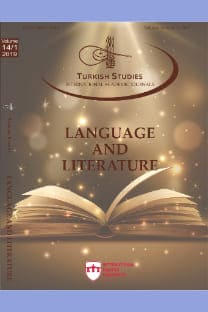Representation of Daphne and Apollo Myth in Postmodern Consumption Culture
Representation of Daphne and Apollo Myth in Postmodern Consumption Culture
___
- Adorno, T. & Horkheimer, M. (2010). Aydınlanmanın diyalektiği. (Çev. N. Ünler & E. Ö. Karadoğan). Kabalcı Yayınevi.
- Akıncı Yüksel, A. (2016). Metin Erksan’ın kuyu filminin mitolojiye dayalı bir perspektiften çözümlenmesi. Anadolu Üniversitesi Sosyal Bilimler Dergisi, 16(4), 129-134. https://doi.org/10.18037/ausbd.415566
- Altuntuğ, N. (2013). Tüketim ve tüketicinin geleceğinde kaynağını mitolojiden alan mistik pazarlamanın etkisi, Organizasyon ve Yönetim Bilimleri Dergisi, 5(2), 119-133. https://dergipark.org.tr/tr/pub/oybd/issue/16342/171140
- Aslan, E. (2019). Günümüz kent toplumunda mitin dönüşümü ve sürekliliği: Ufo [Yayımlanmamış doktora tezi]. Gazi Üniversitesi Sosyal Bilimler Enstitüsü.
- Baudrillard, J. (1997). Tüketim toplumu. (Çev. H. Deliçaylı &F. Keskin). Ayrıntı Yayınları. Bulut, M. & Sezener, A. (2019). Dumuzi-Enkimdu’dan, Kabil-Habil’e yerleşik hayatın serüveni. Turkish Studies, 14(6), 3071-3081. http://dx.doi.org/10.29228/TurkishStudies.23495
- Campbell, J. (2017). Kahramanın sonsuz yolculuğu. (Çev. S. Gürses). İthaki Yayınları.
- Çağlar. B. (2008). Türk mitolojisinde dört unsur ve simgeleri üzerine bir inceleme. [Yayımlanmamış yüksek lisans tezi]. Kocaeli Üniversitesi, Sosyal Bilimler Enstitüsü.
- Coşkun-Onan, B. & İpek, G. (2021). Günümüz sanat eserlerinde Apollon ve Dionysos karşıtlığı: Sanatsal organizasyon ilkeleri temelinde okumalar. Turkish Studies - Language, 16(3), 1543- 1558. https://dx.doi.org/10.7827/TurkishStudies.52322
- Defne Belediyesi. Defne Apollon Anıtı. https://www.defne.bel.tr/project/defne-apollon-aniti/ Erişim tarihi: 25.07.2021
- Douglas, M. & Baron, I. (1999). Tüketimin antropolojisi. (Çev. E. A. Aytekin ). Dost Kitabevi Yayınları.
- Downey, G. (1963). Ancient antioch. Princeton University Press.
- Downey, G. 1959. Libanius’ oration in praise of antioch (oration XI). Proceedings of the American Philosophical Society 103(5), 652–686.
- Eliade, M. (1993). Mitlerin özellikleri. (Çev. S. Rifat ). Simavi Yayınları.
- Eliade, M. (1994). Ebedi dönüş mitosu. (Çev. Ü. Altuğ). İmge Kitabevi.
- Eliade, M. (2009). Dinler tarihine giriş. (Çev. L. Arslan). Kabalcı Yayınları.
- Erhat, A. (2015). Mitoloji sözlüğü. Remzi Kitabevi.
- Etöz, Z. (2011). Mitos ve iktidar. Ankara Üniversitesi SBF Dergisi, 66(3), 157-176.
- Featherstone, M. (1996). Postmodernizm ve Tüketim kültürü. (Çev. M. Küçük). Ayrınt Yayınları.
- Graves, R. (2004). Yunan mitleri. (U. Akpur Çev.). Say Yayınları.
- Güzel, Y., Güzelşemme, M. & Miski, M. (2015). Ethnobotany of medicinal plants used in Antakya: A multicultural district in Hatay Province of Turkey. Journal of ethnopharmacology, 118– 152. https://doi.org/10.1016/j.jep.2015.07.042
- Horkheimer, M. (2010). Akıl tutulması. (Çev. O. Koçak). Metis Yayınları.
- İleri, B. & Aysever, E. (2021) Hediyelik (hatıra) eşya tasarımı: Hatay arkeoloji müze mağazası için bir uygulama. İdil, 563–577. https://dx.doi.org/10.7816/idil-10-80-02
- Kreinath, J.(2020). Water Sanctuarıes Of Hatay, Turkey. Sacred Waters A Cross-Cultural Compendium of Hallowed Springs and Holy Wells ( Edt. Celeste Ray), Routledge.225- 234.
- Levi-Strauss, C. (2013). Mit ve Anlam. (Çev. G. Y. Demir). İthaki Yayınları.
- Malalas, J. (1984). The chronicle. (İng. Çev. Elizabeth Jeffreys, Michael Jeffreys and Roger Scott). Australian Association for Byzantine Studies.
- Ogden, D. (2017). The legend of seleucus kingship, narrative and mythmaking in the ancient world. Cambridge University Press.
- Oğuz, M. Ö. (2013). Küreselleşme ve uygulamalı halk bilimi. (II. baskı). Akçağ Yayınları.
- Özcan, A. (2020). Hatay halk kültüründe defne ağacı [Yayımlanmamış yüksek lisans tezi] Hatay Mustafa Kemal Üniversitesi Sosyal Bilimler Enstitüsü.
- Pouzadoux, C. (2004). Masal ve efsaneler-olympos tanrıları. (Çev. E. Sunar). Say Çocuk Yayınevi.
- Reyhanoğlu, G. & Özcan, A. (2021). İnançtan anlatıya: Hatay halk kültüründe defne, Uluslararası Halkbilimi Araştırmaları Dergisi, 4(6), 62-87. https://dergipark.org.tr/tr/pub/uhad/issue/62633/862951
- Ritzer, G. (2000). Büyüsü bozulmuş dünyayı büyülemek. (Çev. Ş. S. Kaya). Ayrıntı Yayınları Sarı, B. (2019). Modernizmden postmodernizme tüketimin evrimi ve ekonomi politiğini anlamak. Elektronik Sosyal Bilimler Dergisi, 18(70), 554-568. https://doi.org/10.17755/esosder.404495
- Sennett, R. (2010). Kamusal insanın çöküşü. (Çev. S. Durak & A. Yılmaz). Ayrıntı Yayınları.
- Sennett, R. (2012). Karakter aşınması. (Çev. B. Yıldırım). Ayrıntı Yayınları.
- Tan, E.T. (2014). Mitolojik imgeleri tüketmek. International Journal of Human Sciences, 11(2), 138- 154. https://doi.org/10.14687/ijhs.v11i2.2902
- Tandaçgüneş, N. (2012). Roland Barthes’ı yeniden okumak: Tüketim kültüründe inisiyasyon ve alışveriş merkezleri ilişkisi, Marmara İletişim Dergisi, (19), 40-63. https://dergipark.org.tr/tr/pub/maruid/issue/23982/266912
- Tanpınar, A.H. (2007). Bütün şiirleri. Dergah Yayınları.
- Üçeçam Karagel, D. (2018). Hatay ili yerleşme coğrafyası- 1. Pegem Yayınları.
- Yanıklar, C. (2010). Tüketim kültürü, kapitalizm ve insan ihtiyaçları arasındaki ilişki üzerine bir tartışma. Cumhuriyet Üniversitesi Edebiyat Fakültesi Sosyal Bilimler Dergisi, 34(1), 25-32. https://dergipark.org.tr/tr/pub/cumusosbil/issue/4342/59313
- Yıldırım, N. (2018). Antiocheia’dan Antakya’ya bir kent adının serüveni üzerine analizler. Cappadocia Journal Of History And Social Sciences 10 April-2018, 150-162. https://doi.org/10.18299/cahij.189
- Yıldırım, N. &Temizkan, M. (2018). Seleukoslar döneminde Antiokheia’da sosyal ve kültürel yaşam üzerine analizler. International Journal of Social Sciences and Education Research, 4(4), 645-660. https://doi.org/10.24289/ijsser.463166 https://www.defne.bel.tr/project/defne-apollon-aniti/ Erişim tarihi: 25.07.2021
- ISSN: 2667-5641
- Yayın Aralığı: 4
- Başlangıç: 2006
- Yayıncı: ASOS Eğitim Bilişim Danışmanlık Otomasyon Yayıncılık Reklam Sanayi ve Ticaret LTD ŞTİ
Hızır bin Abdullah’ın Kitab’ü-l Edvar’ında Müzik ve Kozmogoni
Klasik Türk Şiirinin Deyim Dünyasında Teşbîh Sanatının Somutlaştırma İşlevi
Sennur Sezer’in Şiirlerinde “Su” İmgesi
Mavi Anadoluculuk’ta Batı Medeniyeti, Anadolu Kimliği, Halk ve Hümanizma Anlayışı
Yaşar Kemal’in Ölmez Otu Romanında Mekânsal Referans Çerçeveleri
Woman in the Novels of Muazzez Aruoba
Klasik Türk Edebiyatının Eğlenceli Tipleri I: Kâsebâz
Kırgız Türkçesinde Duygu Fiillerinin Semantik Yapısı ve Etimolojisi Üzerine Bir İnceleme
